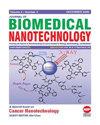Pterostilbene-Loaded Polydopamine Nanoparticles Down-Regulate Tumor Necrosis Factor-α and Improve Myocardial Function in Mice with Acute Myocardial Infarction
IF 2.9
4区 医学
Q1 Medicine
引用次数: 0
Abstract
TNF-α expression is related to myocardial function damage and recovery in patients with acute myocardial infarction, but its mechanism is not clear. 50 SD mice, 10 in each group, were in this study divided into TNF-α group, Notch1/eIF3a agonist group, model group, positive control group, and control group. The cardiac function score, myocardial infarction volume, myocardial cell apoptosis index, TNF-α expression, and Notch1/eIF3a pathway factor expression were observed. The size of polydopamine nanoparticles carrying pterostilbene was about 15.5 nm, and cardiac function score, myocardial infarction volume, myocardial cell apoptosis index, and myocardial cell apoptosis number in the model group and Notch1/eIF3a agonist group were higher than model group and Notch1/eIF3a agonist group (P < 0.05). Compared with model group, the Notch1/eIF3a agonist group, TNF-α group, and positive control group showed no differences (P > 0.05). The model group and Notch1/eIF3a agonist group had highest inflammatory response and lowest oxidative stress, which were significantly different from other groups (P < 0.05). The expression of TNF-α in Notch1/eIF3a agonist group, model group, and positive control group all decreased, which was significantly different from other groups (P < 0.05). The expressions of p-IL-6 and p-eIF3a in model group, Notch1/eIF3a agonist group and positive control group were all highest (P < 0.05). Carrying Pterostilbene-loaded polydopamine nanoparticles (PPNs) therefore inhibits apoptosis of cardiomyocytes, Notch1/eIF3a signaling pathway and inflammatory response and oxidative stress of myocardial system, and protects cardiomyocytes of model mice.紫檀烯负载型多多巴胺纳米粒子能下调肿瘤坏死因子-α并改善急性心肌梗死小鼠的心肌功能
TNF-α的表达与急性心肌梗死患者的心肌功能损伤和恢复有关,但其机制尚不清楚。本研究将 50 只 SD 小鼠分为 TNF-α 组、Notch1/eIF3a 激动剂组、模型组、阳性对照组和对照组,每组 10 只。观察心功能评分、心肌梗死体积、心肌细胞凋亡指数、TNF-α表达和Notch1/eIF3a通路因子表达。携带紫檀芪的多多巴胺纳米颗粒大小约为15.5 nm,模型组和Notch1/eIF3a激动剂组的心功能评分、心肌梗死体积、心肌细胞凋亡指数和心肌细胞凋亡数量均高于模型组和Notch1/eIF3a激动剂组(P<0.05)。与模型组相比,Notch1/eIF3a 激动剂组、TNF-α 组和阳性对照组无差异(P > 0.05)。模型组和 Notch1/eIF3a 激动剂组的炎症反应最高,氧化应激最低,与其他组相比差异显著(P < 0.05)。Notch1/eIF3a激动剂组、模型组和阳性对照组的TNF-α表达量均下降,与其他组相比有明显差异(P<0.05)。模型组、Notch1/eIF3a 激动剂组和阳性对照组的 p-IL-6 和 p-eIF3a 表达量均最高(P < 0.05)。因此,携带紫檀芪多巴胺纳米颗粒(PPNs)可抑制心肌细胞凋亡、Notch1/eIF3a 信号通路以及心肌系统的炎症反应和氧化应激,保护模型小鼠的心肌细胞。
本文章由计算机程序翻译,如有差异,请以英文原文为准。
求助全文
约1分钟内获得全文
求助全文
来源期刊
CiteScore
4.30
自引率
17.20%
发文量
145
审稿时长
2.3 months
期刊介绍:
Information not localized
文献相关原料
| 公司名称 | 产品信息 | 采购帮参考价格 |
|---|

 求助内容:
求助内容: 应助结果提醒方式:
应助结果提醒方式:


